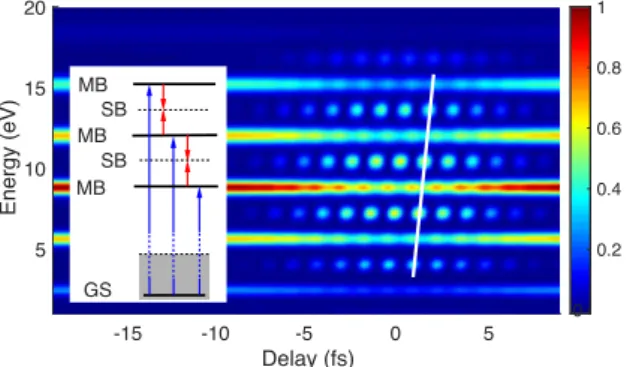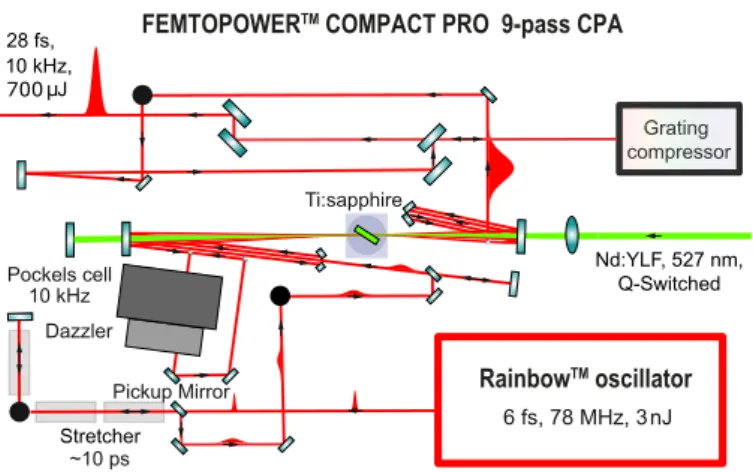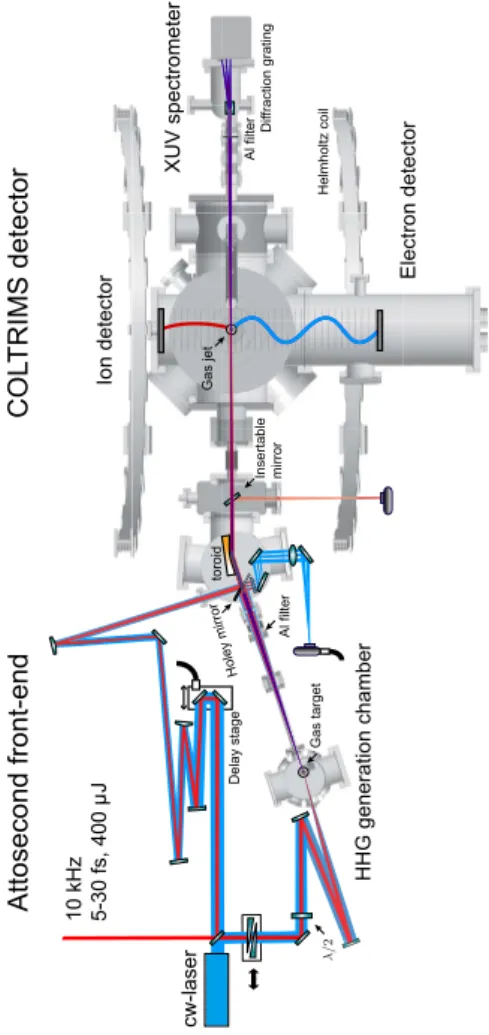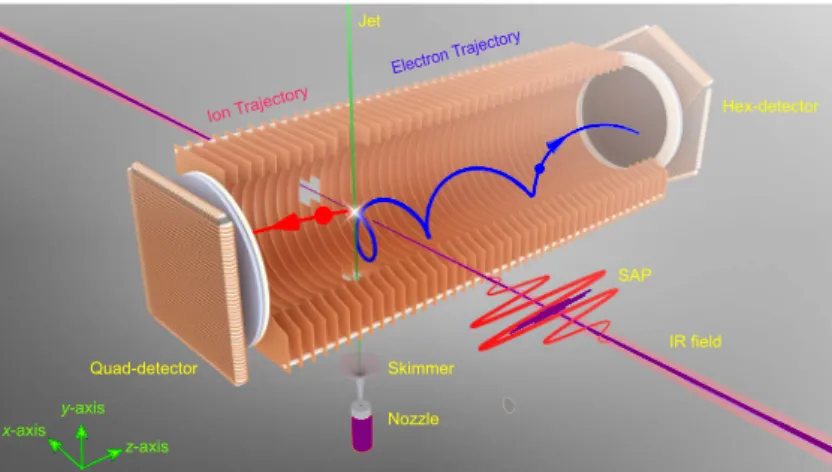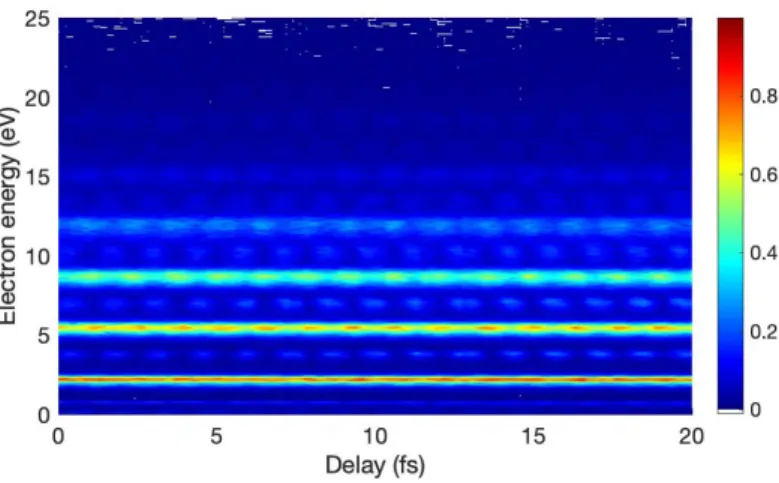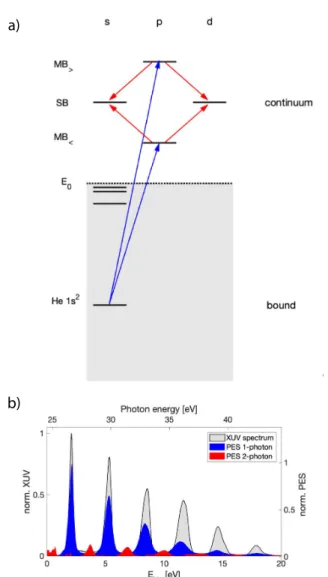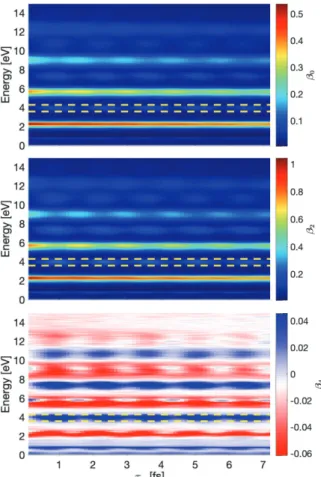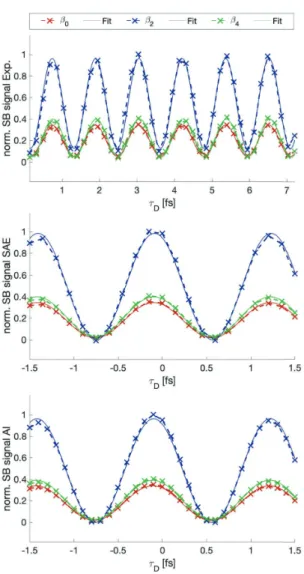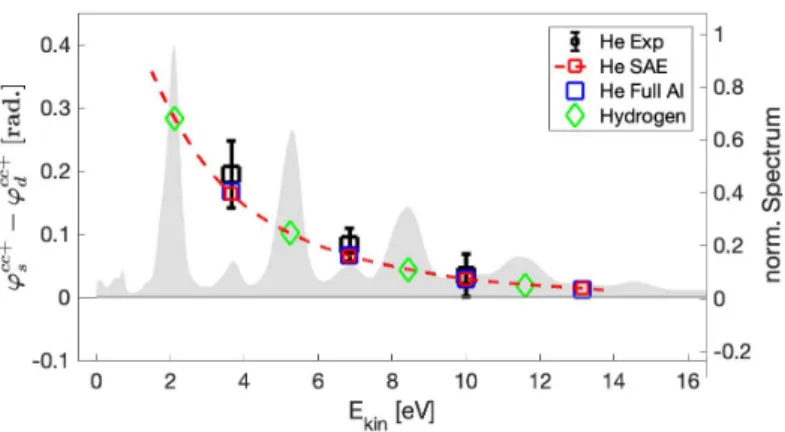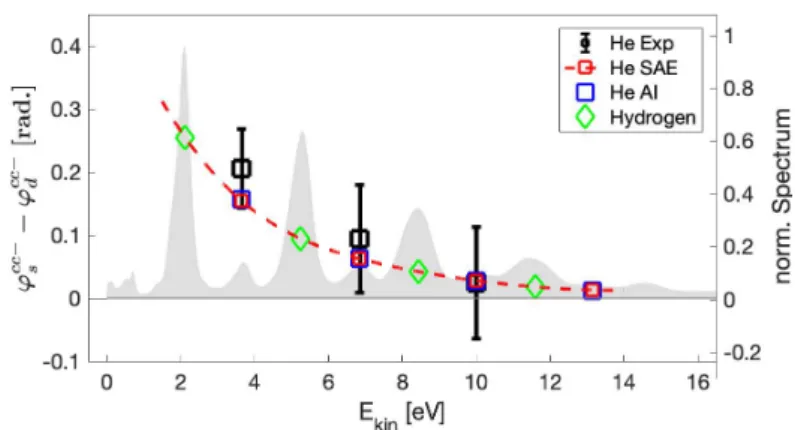Research Collection
Doctoral Thesis
Novel Schemes of Attosecond Interferometry
Author(s):
Fuchs, Jaco Publication Date:
2021
Permanent Link:
https://doi.org/10.3929/ethz-b-000475673
Rights / License:
In Copyright - Non-Commercial Use Permitted
This page was generated automatically upon download from the ETH Zurich Research Collection. For more information please consult the Terms of use.
ETH Library
Diss. ETH No. 27367
N ovel schemes of attosecond interferometry
A thesis submitted to attain the degree of DOCTOR of SCIENCES of ETH ZURICH
(Dr. sc. ETH Zurich)
presented by JACO FUCHS
MSc Physics, Universität Stuttgart, born on 20.09.1993, citizen of Germany.
Accepted on the recommendation of Prof. Dr. Ursula Keller, examiner Prof. Dr. Anne L’Huillier, co-examiner
2021
Contents
Contents i
List of figures v
List of tables vii
List of symbols and acronyms ix
Publications xiii
Journal papers . . . xiii
Conference papers . . . xiv
Abstract xvii Kurzfassung (German) xix 1 Introduction 1 2 Attosecond photoionization spectroscopy 7 2.1 Attosecond pulse generation . . . . 8
2.1.1 High harmonic generation . . . . 8
2.1.2 Attosecond pulse train . . . . 11
2.2 Attosecond pump-probe experiments . . . . 12
2.2.1 Reconstruction of attosecond beating by interference of two-photon transitions (RABBITT) . . . . 13
2.2.2 Photoionization time delays . . . . 16
3 Experimental setup 19 3.1 Laser system . . . . 19
3.1.1 Rainbow laser oscillator . . . . 20
3.1.2 Chirped pulse amplifier . . . . 21
3.2 Attosecond front-end . . . . 22
C ontents
3.3 COLTRIMS detector . . . . 24
3.3.1 Momenta reconstruction . . . . 26
4 Angle-resolved attosecond interferometry 31 4.1 Time delays from one-photon transitions in the continuum 33 4.1.1 Introduction . . . . 34
4.1.2 Theoretical framework . . . . 37
4.1.3 Experimental results . . . . 40
4.1.4 Theoretical results . . . . 43
4.1.5 Discussion . . . . 45
4.1.6 Conclusion and outlook . . . . 51
4.2 Derivation of the anisotropy parameters . . . . 52
4.3 Analytic solution for the phase differences . . . . 55
4.4 Investigation of larger atoms . . . . 58
4.5 Outlook . . . . 62
5 Attosecond interferometry employing overlapping high harmon- ics 63 5.1 Towards the complete phase profiling of attosecond wave packets . . . . 65
5.1.1 Supplemental material . . . . 76
5.2 Detailed derivation of the angle-resolved spectra . . . . 79
5.3 Atto- and femtochirp in attosecond pulse trains . . . . 81
5.4 Reconstruction of absolute phases . . . . 84
5.5 Outlook . . . . 88
6 Free-running quantum interferometry 89 6.1 Attosecond resolution from free running interferometric mea- surements . . . . 91
6.1.1 Introduction . . . . 91
6.1.2 The method . . . . 95
6.1.3 Comparison between TURTLE and the sine-fit anal- ysis . . . . 96
6.1.4 Proof-of-principle experiment . . . . 99
6.1.5 Conclusion . . . 100
6.2 Investigation of molecular photoionization time delays with TURTLE . . . 103
6.3 Outlook . . . 108
7 Attosecond photoionization spectroscopy just above threshold 109 7.1 Helium RABBITT measurement just above threshold . . . . 110
7.2 Photoionization delays arising from the helium excited states resonances . . . 112
7.3 Stark effect . . . 113
7.4 Delays from one-photon ionization . . . 116
7.5 Outlook . . . 118
8 Conclusion 119
ii
Contents
Author contributions 123
References 125
Curriculum Vitæ 139
Acknolwedgements 141
List of figures
2.1 Simple-man-model . . . 8
2.2 High harmonic spectrum . . . 9
2.3 Attosecond pulse train . . . 11
2.4 RABBITT . . . 13
2.5 Wigner scattering phase . . . 16
3.1 Layout of the laser oscillator . . . 20
3.2 Laser amplifier . . . 21
3.3 Attosecond pump-probe delay line . . . 23
3.4 COLTRIMS detector . . . 25
3.5 Experimental momentum spectra . . . 28
3.6 Experimental RABBITT spectrum in helium . . . 29
4.1 Schematic of the quantum path interference in helium . . . 35
4.2 Experimental anisotropy parameters of the time-resolved photoelectron angular distribution in helium . . . 41
4.3 Simultaneous fit of the sideband anisotropy parameters of helium . . . . 44
4.4 Cc-phase difference betweens- andd-partial waves for absorption . . . . 46
4.5 Cc-phase difference betweens- andd-partial waves for stimulated emis- sion . . . 48
4.6 Delay and absolute phase offset betweens- andd-partial waves . . . 50
4.7 Schematic of the quantum path interference in argon . . . 59
4.8 Experimental anisotropy parameters of the time-resolved photoelectron angular distribution in argon . . . 61
4.9 Simultaneous fit of the sideband anisotropy parameters of argon . . . 62
5.1 Illustration of the 1-2-quantum beat method . . . 68
5.2 Experimental asymmetry spectrogram . . . 69
5.3 Simulated assymetry spectrogram . . . 72
5.4 Influence of periodic spectral phase osciilations on an APT . . . 75
5.5 Simulated photoelectron yield in for two-color photoionization . . . 77
5.6 Transition rates for the IR induced cc-transitions . . . 77
5.7 Atto- and femtochirp in attosecond pulse trains . . . 83
5.8 Scheme to retrieve absolute phases . . . 84
5.9 Absolute phase reconstructed from the SAE simulation . . . 87
L ist of figures
5.10 Absolute phase reconstructed from the experiment . . . 87
6.1 Example RABBITT spectrum . . . 93
6.2 Illustration of the TURTLE method . . . 95
6.3 Precision of TURTLE and traditional sine-fitting . . . 97
6.4 Experimental RABBITT traces obtained by thermal drift . . . 99
6.5 Illustration of the TURTLE ellipse . . . 102
6.6 Theoretical acetylene photoelectron spectrum . . . 104
6.7 Experimental acetylene photoelectron spectrum . . . 105
6.8 Acetylene RABBITT spectra . . . 106
6.9 Turtle ellipse fits of the simultaneous acetylene-helium RABBITT . . . . 107
7.1 Signatures of the helium 1snp-excited states in a RABBITT measurement 110 7.2 Sideband oscillations arising from the 1snp-excited states . . . 113
7.3 Energy shift of the helium 1s4p-signature . . . 114
7.4 Experimental anisotropy parameters of the helium RABBITT just above threshold . . . 115
7.5 Simultaneous fit of the anisotropy parameters for the helium RABBITT sideband 16 . . . 116
7.6 Phase differences betweens- andd-partial waves just above threhold . . 117
vi
List of tables
4.1 Algebraic values of the integrals for the derivation of the anisotropy
parameters . . . 55
4.2 Phase difference betweens- andd-partial waves in argon . . . 61
6.1 Adiabatic ionization potentials of acetylene . . . 105
6.2 Acetlyne-helium delay retrieved with Turtle . . . 106
7.1 Time delays between the helium excited states signatures . . . 113
List of symbols and acronyms
Symbols
A vector potential α electron emission angle B magnetic field
c speed of light in vacuum c.c. complex conjugated E electric field e elementary charge
E energy
E
cut−o f fcut-off energy E
HHartree energy E
kinkinetic energy E
XUVXUV photon energy ε
0vacuum permittivity
f
CEOcarrier-envelope offset frequency f
reprepetition rate
h Planck constant
¯
h reduced Planck constant I intensity of electromagnetic field I
pionization potential
λ wavelength
S ymbols
` angular momentum quantum number L
Hdistance interaction region - Hex detector L
Qdistance interaction region - Quad detector m magnetic quantum number
p electron momentum
ϕ polar angle in radial coordinates ϕ
cccontinuum-continuum phase ϕ
CEPcarrier-envelope phase
ϕW Wigner phase
ϕ
XUVXUV spectral phase U
pponderomotive energy
ψ wave function
p
xelectron momentum in x-direction p
yelectron momentum in y-direction p
zelectron momentum in z-direction
q charge
τ pump-probe delay
τ
WWigner time delay T
ccyclotron period
ϑ azimuthal angle in radial coordinates t
TOFtime-of-flight
V potential
ω angular frequency ω
IRIR angular frequency
x
Acronyms
Acronyms
AIS active interferometer stabilization
Al aluminum
AOM acousto-optic modulator APT attosecond pulse train
Ar argon
BS beam splitter
CEO carrier-envelope offset CEP carrier-envelope phase
COLTRIMS cold target recoil ion momentum spectrometer CPA chirped pulse amplifier
cw continuous wave
EWP electron wave packet EWS Eisenbud-Wigner-Smith FEL Free-electron laser
FWHM full width at half maximum
GD group delay
GDD group delay disperison
H hydrogen
He helium
HH high harmonic
HHG high harmonic generation
IR infrared
KLM Kerr-lens mode-locking
MB mainband
MCP micro channel plate
Ne neon
OC output coupler
PD photo diode
PES photoelectron spectrum
PPLN periodically poled lithium niobate
A cronyms
RABBITT reconstruction of attosecond beating by interference of two-photon transitions
SAE single-active-electron SAP single attosecond pulse
SB sideband
SE Schrödinger equation SPM self-phase modulation
TDSE time-dependent Schrödinger equation Ti-sapph titanium-doped sapphire
TOF time-of-flight
UV ultra-violet
WKB Wentzel-Kramer-Brillouin
Xe xenon
XUV extreme ultra-violet
xii
Publications
Within the scope of this thesis, the following journal papers and confer- ence contributions were published. The original manuscripts of the jour- nal publications are re-printed with permission in this thesis. The text and figures are printed as published, while the formatting has been adapted to fit the page format of this thesis. Further, the numbering of the figures, tables, references and equations has been adjusted. The reference list of the publication has been included in the reference list at the end of this the- sis. The copyright of the publications is held by the respective copyright holders.
Journal papers
1. Jaco Fuchs, Nicolas Douguet, Stefan Donsa, Fernando Martin, Joachim Burgdörfer, Luca Argenti, Laura Cattaneo and Ursula Keller,
«Time delays from one-photon transitions in the continuum», Optica 7(2), 154-161 (2020), doi.org/10.1364/optica.378639
2. Constantin Krüger,* Jaco Fuchs,* Laura Cattaneo, and Ursula Keller,
«Attosecond resolution from free running interferometric measure- ments», Optics express 28(9), 12862-12871 (2020),
doi.org/10.1364/OE.391791, (editors pick)
P ublications
3. Jaco Fuchs, Nicolas Douguet, Stefan Donsa, Fernando Martin, Joachim Burgdörfer, Luca Argenti, Laura Cattaneo and Ursula Keller,
«Towards the complete phase profiling of attosecond wave packets», ArXiv:2012.07426, http://arxiv.org/abs/2012.07426
Conference papers
1. Johanna Vos, Laura Cattaneo, Luca Pedrelli, Jaco Fuchs and Ursula Keller, «Dynamical decay of a Shape Resonance in N2O»,
Molecular Ultrafast Science and Technology (MUST) Annual Meeting (7th),
Grindelwald, Switzerland (2017). (Poster).
2. Jaco Fuchs, Nicolas Douguet, Stefan Donsa, Fernando Martin, Joachim Burgdörfer, Luca Argenti, Laura Cattaneo and Ursula Keller,
«Time delays from one-photon transitions in the continuum», 7th International Conference on Attosecond Science and Technology (ATTO2019), Szeged, Hungary (2019). (Talk).
3. Jaco Fuchs, Nicolas Douguet, Stefan Donsa, Fernando Martin, Joachim Burgdörfer, Luca Argenti, Laura Cattaneo and Ursula Keller,
«Time delays from one-photon transitions in the continuum», Ultra- fast Science and Technology Spain 2019 (USTS meeting 2019), Madrid, Spain (2019). (Poster).
4. Jaco Fuchs, Nicolas Douguet, Stefan Donsa, Fernando Martin, Joachim Burgdörfer, Luca Argenti, Laura Cattaneo and Ursula Keller,
«Time delays from one-photon transitions in the continuum», Con- ference on Lasers and Electro-Optics (CLEO), San Jose, USA (2020), (Talk, Maiman student paper award).
5. Luca Argenti, Jaco Fuchs, Nicolas Douguet, Stefan Donsa, Fernando Martin, Joachim Burgdörfer, Laura Cattaneo and Ursula Keller,
«Time delays from one-photon transitions in the continuum», APS
xiv
Conference papers
division of Atomic, Molecular and Optical Physics (DAMOP meeting), virtual (2020). (Talk).
6. Jaco Fuchs, Nicolas Douguet, Stefan Donsa, Fernando Martin, Joachim Burgdörfer, Luca Argenti, Laura Cattaneo and Ursula Keller,
«Time delays from one-photon transitions in the continuum», Ultra- fast Phenomena 2020, Shanghai, China (2020). (Talk, given by L.A.).
7. Jaco Fuchs, Constantin Krüger, Laura Cattaneo and Ursula Keller,
«Attosecond resolution from free running interferometric measure- ments», Ultrafast Phenomena 2020, Shanghai, China (2020). (Talk).
8. Jaco Fuchs, Nicolas Douguet, Stefan Donsa, Fernando Martin, Joachim Burgdörfer, Luca Argenti, Laura Cattaneo and Ursula Keller,
«High-order phase profiling of attosecond wave packets», Ultrafast
Phenomena 2020, Shanghai, China (2020). (Poster).
Abstract
Attosecond science investigates physical phenomena on the attosecond timescale. On this timescale, exclusively optical pulses enable the required temporal resolution. However, state-of-the-art attosecond light sources are too weak to enable pure attosecond pump - attosecond probe measure- ments. One of the major challenges of attosecond science is, therefore, the development of alternative techniques to achieve attosecond resolution.
In this thesis, novel interferometry schemes for the measurement of at- tosecond dynamics are presented. These schemes are based on the quan- tum path interference in attosecond XUV pump - femtosecond IR probe experiments. The well-established Reconstruction of Attosecond Beating by Interference of Two-photon Transitions (RABBITT) technique is devel- oped further and new fundamental physics discoveries are made.
First, an experimental procedure is presented, which allows for the
quantification of time delays in the photoionization process arising from
single-photon transitions in the electronic continuum. The found delays
demonstrate an angular momentum contribution to the photoionization
time delay. Together with numerical simulations and analytic estimates,
the experimental values suggest a universal character across different
chemical species.
A bstract
Second, a RABBITT-type experiment employing spectrally broad, over- lapping high harmonics is presented. The broad harmonics lead to a quan- tum beating between one-photon and two-photon transitions, which re- veals additional phase information about the underlying attosecond pulse train. Periodic oscillations of the spectral phase of an attosecond pulse train are found, demonstrating that each harmonic is individually chirped.
Finally, an analysis procedure of RABBITT-type experiments is pre- sented, which demonstrates that an attosecond delay control is not re- quired to achieve attosecond resolution. This technique relaxes the exper- imental demands of attosecond interferometric measurements and more- over enables attosecond measurements at Free-electron lasers, where a femtosecond timing jitter is present.
For the experiments presented in this thesis, a COLTRIMS detector is used. In contrast to existing attosecond interferometry methods, the here presented methods involve not only the phase but also the amplitude and modulation depth of the resolved oscillations in the time-dependent pho- toelectron spectra, to infer information about the underlying attosecond dynamics. The coincidence detection capability of the detector of the COLTRIMS detector supports this approach.
xviii
Kurzfassung (German)
Das Ziel der Attosekunden-Physik ist die Untersuchung von Naturphäno- menen auf einer Attosekunden-Zeitskala. Ausschliesslich optische Licht- pulse ermöglichen die dafür erforderliche zeitliche Auflösung. Selbst hoch- moderne Attosekunden-Lichtquellen sind allerdings nicht ausreichend stark, um reine Attosekunden-Pump-Probe-Messungen durchzuführen.
Eine der grössten Herausforderungen in der Attosekunden-Physik ist da- her die Entwicklung alternativer Messmethoden, welche dennoch eine at- tosekundengenaue Auflösung ermöglichen.
In dieser Dissertation werden neue Interferometrie-Methoden zur Messung von Attosekunden-Dynamiken vorgestellt. Die vorgestellten Methoden basieren auf der Quantenpfad-Interferenz in kombinier- ten Attosekunden-XUV-Pump-Femtosekunden-IR-Probe-Messungen. Da- bei werden die bereits etablierte RABBITT-Methode (Reconstruction of At- tosecond Beating By Interference of Two-photon Transitions) weiterentwi- ckelt und neue physikalische Entdeckungen präsentiert.
Als Erstes wird eine experimentelle Methode zur Messung von Atto-
sekunden Zeitverzögerungen im Photoionisationsprozess eingeführt, wel-
che durch die Interaktion mit einzelnen Photonen verursacht werden. Die
gefundenen Zeitverzögerungen weisen einen Beitrag auf, welcher durch
den Drehimpuls der emittierten Elektronen bestimmt wird. In Verbindung
mit numerischen Simulationen und einer analytischen Abschätzung zei-
gen die experimentellen Messungen, dass dieser Beitrag universell für die
K urzfassung (G erman )
Elektronen-Emission in unterschiedlichen chemischen Elementen ist.
Als Zweites wird ein der RABBITT-Technik ähnliches Experiment mit spektral überlappenden, höheren Harmonischen präsentiert. Die spek- tral verbreiterten Harmonischen führen zu einer Quantenpfad-Interferenz von 1-Photonen- und 2-Photonen-Übergängen, welche zusätzliche Phasen- Informationen über den zugrunde liegenden Attosekunden-Pulszug ent- hüllt. Dabei werden periodische Oszillationen in der spektralen Phase der Attosekunden-Pulszüge entdeckt, welche einen individuellen Chirp der einzelnen Harmonischen implizieren.
Zum Schluss wird eine Technik zur Auswertung von RABBITT- Messungen vorgestellt, welche aufzeigt, dass prinzipiell weder Attosekunden-Pulse noch Attosekunden-Scans notwendig sind, um eine Attosekundengenauigkeit zu erreichen. Diese Technik vereinfacht zukünf- tige RABBITT-Experimente und ermöglicht Attosekunden-Messungen an Freie-Elektronen-Lasern, welche einer Femtosekunden-Zeitinstabilität unterliegen.
Für die Experimente, welche in dieser Arbeit vorgestellt werden, wur- de ein COLTRIMS-Detektor benutzt. Im Gegensatz zu herkömmlichen Attosekunden-Interferometrie-Methoden werden in den hier vorgestell- ten Methoden nicht nur die Phase, sondern auch die Amplitude und Modulationstiefe der gemessenen Oszillationen in den zeitabhängigen Photoelektronen-Spektren ausgenutzt, um Informationen über die Atto- sekunden Dynamik zu erhalten. Die Koinzidenz-Detektions-Möglichkeit des COLTRIMS-Detektors trägt massgeblich zu diesem Ansatz bei.
xx
Chapter 1
Introduction
How can one measure time? - In everyday life, a "stopwatch" method enables a convenient and suitable timing method. When starting a process, say a 100 m-sprint, a stopwatch is started, and at the finish the time is read out. For many important scientific questions the stopwatch method is, however, not suitable: How old is the human race? How old is the earth?
Or even: How old is the universe? And on the shorter timescale: How long does a virus need to enter a cell? How long do chemical reactions take? How long does it take for an electron to leave an atom? To answer these questions, other timing techniques are required.
The stopwatch method has two fundamental limitations. First, one needs to wait for the entire duration of the process. This sets an upper limit for the measurable time, e.g., one cannot wait for the full 4.5 billion years of the formation of another earth-like planet. For longer timescales, indirect methods have to be used, such as the radiocarbon method for dating the age of fossils or the extrapolation of the Hubble-constant for estimating the age of the universe. However, for such indirect methods, preliminary knowledge is required.
Second, on the shorter timescales, the stopwatch method is limited by
detector times. Naturally, one cannot measure shorter times than it takes
to monitor the process. Let’s consider a high-speed microscope that tries
to observe a virus entering a cell. The camera acquires a single picture in
a few milliseconds, but the virus may enter the cell during a few microsec-
1. I ntroduction
onds. The resulting high-speed movie would not reveal any information about the actual penetration. One may give a lower boundary for the stop- watch method of a few picoseconds (1 ps = 10
−12s), corresponding to the fastest transistor switching times.
Besides indirect methods, stroboscopic measurements can be employed.
Let’s consider again the virus entering the cell. If one synchronizes a short flash with the virus docking into the cell, the camera is exposed only for the duration of the flash, in an otherwise dark surrounding. Then, even if the acquisition time of a single picture is much longer than the entire process, only the short period of the flash is imaged. By repeating the experiment with different timings of the flash, the resulting series of pic- tures can be combined to a movie, with a better temporal resolution than the actual camera acquisition time. The only limitations are the synchro- nization of the flash, the flash duration, and, of course, repeatability of the process.
Optical pump-probe measurements follow this principle. A "pump"
laser pulse initiates a process and a delayed "probe" laser pulse tests the process. The usage of laser pulses proved to be very successful since extremely short pulse durations can be achieved, orders of magnitude shorter than, e.g., electrical signals. Only three decades after the first laser in 1960 [1], laser pulses of a few femtoseconds (1 fs = 10
−15s) became available in the visible/infrared (IR) regime[2]. Then, with the turn of the millennium attosecond pulses (1 as = 10
−18s) were demonstrated [3, 4].
A few years later, attosecond photoionization time delays were measured in a pump-probe experiment [5, 6].
In principle, also for the short timescales, indirect timing methods are available. In the attoclock method, the emission angle of photoelectrons in a few-cycle elliptically polarized laser field is used to infer informa- tion about attosecond tunneling times[7]. In the LIGO experiment, length changes of the interferometer arms in a Michelson interferometer are de- tected, essentially corresponding to a delay of the laser light < 10
−27s.
However, indirect methods cannot probe different instants of time.
2
Why attosecond science? - Within one attosecond light travels 3 · 10
−10m, i.e., about the size of a small atom. Being restricted by the speed of light, generally, no physical information can travel farther in this time. Conse- quently, no observable effect at all can be expected on this timescale on a macroscopic level, and, in principle, not even on a molecular level. Naively, one may ask: Why is the attosecond timescale relevant? For typical elec- tron binding energies, the associated oscillation period of the quantum mechanical wave function, τ = h/E, lies exactly on this timescale (e.g., the atomic unit of time, defined as τ
a= ¯ h/E
H, is 24 as). In turn, the quantum mechanical interference, which ultimately leads to relevant macroscopic effects, is determined on this timescale. For example, the interference of different wave functions and partial waves may influence the emission an- gle of a photoelectron, determine the outcome of a chemical reaction, or even increase or decrease the efficiency of a solar cell.
In the past two decades, attosecond science contributed to our under- standing of electron dynamics in various types of systems ranging from single atoms [6] and molecules [8] to liquids [9], dielectrics [10], semicon- ductors [11] metals [5], nanostructures [12], and certainly more. The com- mon ground of the field is the spectroscopic, methodological knowledge rather than specific knowledge about the investigated materials. Further- more, attosecond science drives the development of cutting-edge laser and detector technologies.
Due to the required spectral bandwidth, attosecond pulses have a cen-
ter wavelength that lies in the extreme ultraviolet (XUV) spectral range
or at even shorter wavelengths. Measuring with attosecond pulses, hence,
comes with several technical challenges. The major challenge, however, is
that state-of-the-art attosecond XUV light sources are not bright enough
to carry out attosecond pump - attosecond probe experiments. Intriguing
and innovative pump-probe schemes using a combination of attosecond
XUV pump and femtosecond IR probe have to be developed to enable at-
tosecond resolution. Ultimately, it is exactly the above-described quantum
interference that allows for attosecond measurements.
1. I ntroduction
What is this thesis about? - In this thesis novel XUV-IR interferometric measurement schemes are developed and the thereby found, fundamental physics discoveries are presented. The developed interferometry schemes are based on the quantum path interference in two-color attosecond pho- toionization experiments. They build on the well-established Reconstruc- tion of Attosecond Beating By Interference of Two-photon Transition (RAB- BITT) technique [4, 13] and try to advance it in different facets. Therefore, the research findings presented in this thesis shall not only expand the knowledge horizon at the time of writing but, moreover, contribute to the field of attosecond science on a long-term basis.
Chapter 2 introduces the field of attosecond science, with a particu- lar focus on attosecond photoionization spectroscopy and the RABBITT technique. The generation of attosecond pulse trains via HHG and the retrieval of photoionization time delays via the RABBITT technique is de- tailed. Relevant other attosecond spectroscopies are mentioned.
Chapter 3 describes the experimental setup, which has been used throughout the research work for this thesis. The commercial laser system for the generation of intense femtosecond laser pulses and the subsequent attosecond XUV-IR pump-probe delay line is presented. Further, the coin- cidence detection of photoelectrons and ions with the COLTRIMS detector is described. Details on the experimental acquisition are given.
Chapter 4 presents an angle-resolved RABBITT measurement, which enables the quantification of time delays arising from one-photon tran- sitions in the electronic continuum. To this end, a simultaneous fitting method of the anisotropy parameters of the time dependent electron an- gular distribution in helium is developed. The found delays suggest a universal character across different chemical species. Analytical estimates of the delays are presented. Finally, the method is employed to larger atoms.
Chapter 5 presents the results of a two-color interferometry scheme
employing spectrally overlapping high harmonics. The induced quantum
beating between one-photon and two-photon transitions enables the re-
trieval of detailed phase information about an attosecond pulse train, com-
plementary to the RABBITT technique. The additional phase information
4
enables the observation of periodic spectral phase oscillations due to the femtochirp in an attosecond pulse train, which are inherently inaccessible in the conventional RABBITT technique. An analytic model of attosec- ond pulse trains and an approach towards the reconstruction of absolute phases is presented.
Chapter 6 demonstrates a novel analysis technique of conventional RABBITT experiments which allows for the retrieval of attosecond delays from free-running quantum interferometers. The presented analysis pro- cedure facilitates the measurement of attosecond photoionization time de- lays in table-top experiments and enables the measurement of attosecond delays at large scale facilities, where a femtosecond timing jitter is present.
Chapter 7 presents the results of a conventional RABBITT experiment
in helium in the regime just above threshold. This regime enables a moni-
toring of the ultrafast excited state dynamics and the investigation of reso-
nant two-photon ionization transitions via the excited states. Photoioniza-
tion time delays, induced by the excited states resonances, as well as the
ultrafast Stark-shift are analyzed. The last chapter concludes.
Chapter 2
Attosecond photoionization spectroscopy
Attosecond science is an emerging experimental research area that, by definition, aims to answer scientific questions on an attosecond timescale.
As such, it addresses various types of physical and chemical phenomena, deals with a wide range of materials, and covers investigations in all states of matter. Being unrestricted in what is studied, the common ground of the field is rather how things are studied.
Precise physical triggers in the form of attosecond light pulses are re- quired to probe dynamics on the attosecond timescale. The generation and characterization of attosecond light pulses thereby comprise a major part of the research area. Section 2.1 provides a qualitative, high-level in- troduction on the generation of attosecond light pulses via high harmonic generation (HHG).
Due to the required spectral bandwidth, attosecond pulses necessarily
have a center frequency in the XUV (or even higher energetic) spectral
range. Thus, commonly used pulse characterization methods for optical
pulse are not applicable. Instead, due to their higher energetic frequency
components, attosecond pulses can photoionize typical valence electrons,
such that time-resolved photoelectron spectroscopy can be used to reveal
phase information about the ionizing light pulses. Attosecond photoion-
ization spectroscopy, therefore, comprises both state-of-the-art pulse char-
acterization methods as well as precise timing tools for the study of one
of the most fundamental physical processes, Einsteins’ photoelectric ef-
2. A ttosecond photoionization spectroscopy
Step 1 Step 2 Step 3
Figure 2.1: Simple-man-model (three-step model) : Step 1: An electron tunnels through the binding Coulomb potential, which is bend by a strong laser field. Step 2: In the following laser half cycle the liberated electron wave packet acquires kinetic energy and is accelerated back towards the parental ion. Step 3: The electron radiatively recombines with the parental ion, emitting a high energetic photon.
fect. Section 2.2 provides an introduction to the RABBITT technique for the characterization of attosecond XUV pulses and the measurement of attosecond photoionization time delays. The understanding of RABBITT is a prerequisite for the understanding of the subsequent chapters.
2.1 Attosecond pulse generation
For more than 15 years, attosecond pulses could exclusively be generated via the so-called high harmonic generation (HHG) process [14–16]. Ap- plicable in table-top-experiments, the method has been successfully es- tablished in many research laboratories worldwide. Only recently (2020), attosecond light pulses generated by Free-electron lasers have been demon- strated [17]. However, the achieved pulse durations are still crucially longer than from table-top experiments based on HHG.
2.1.1 High harmonic generation
High harmonic generation (HHG) describes the generation of high-order
harmonics (HH) of a fundamental laser field. It can be intuitively under-
stood in a semi-classical picture known as the three-step model (also sim-
ple man’s model) [15], illustrated in Figure 2.1. When an atom or molecule
is exposed to a strong optical laser field, its binding potential is dressed by
the electric field such that bound electrons can tunnel through the result-
ing potential barrier, effectively releasing a well-localized electron wave
8
2.1. Attosecond pulse generation
Perturbative regime
Plateau
Cut-of f
Photon energy
Log(Intensity)
Figure 2.2: High harmonic spectrum. High order harmonics are generated at odd multiples of the fundamental laser frequency. After a drop of the harmonic yield in the perturbative regime, the harmonic yield stays constant in the plateau region, extending over a larger energy range.
The yield drops again at the cut-off energy, which depends on the ponderomotive energyUp
and the ionization potentialIpof the gas target.
packet in the electronic continuum nearby the ion. This tunnel-ionization is referred to as the first step. When the electric field is reversed in the next laser field half-cycle, the electron wave packet is accelerated back towards its parental ion and gains kinetic energy. This acceleration is referred to as the second step. Finally, when the electron wave packet hits the parental ion, three processes may occur: i) The electron scatters elastically.
ii) The electron scatters inelastically, ionizing further electrons or exciting the ion. iii) The electron radiatively recombines with the ion, emitting a high energetic photon. This last process, i.e., the radiative recombination, completes the three-step-model. Intuitively, as the recombination occurs during a small fraction of the optical laser field, the emitted radiation burst can be expected to have a much shorter pulse duration than one half-cycle, effectively suggesting attosecond light pulses.
The three-step model also allows for quantitative considerations. After
tunnel-ionization, the electrons can be treated classically as point charge
for which Newton’s equation of motion can be solved (with or without
Coulomb potential). The analysis of the return time and return energy of
the liberated electrons reveals two prominent characteristics of the high
harmonic generation.
2. A ttosecond photoionization spectroscopy
First, there is a maximal return energy, which depends on the intensity I and angular frequency ω
0of the fundamental, driving laser field. Hence, there is also a maximal energy for the emitted photons, which is given by
E
cut-off= I
p+ 3.17U
p, (2.1)
where I
pis the ionization potential of the target gas and U
p= 2e
2
cε
0m
eI
4ω
20(2.2)
is the ponderomotive potential. The retrieved harmonic yield can be dis- tinguished in three regimes, illustrated in Figure 2.2. For low harmonics (e.g. 3rd harmonic, 5th harmonic) a perturbative picture is applicable to describe the harmonic yield. Here, the generation efficiency decreases sig- nificantly with higher orders. Next, for higher-order harmonics until the cut-off energy E
cut-offthe simple-man picture is applicable. In this highly non-linear regime, the efficiency only weakly depends on the harmonic order. Therefore, it is referred to as plateau region. For higher energies than E
cut-off, the efficiency finally drops to zero.
Second, the dependence of the return energy on the return time leads to different photon energies being emitted at slightly different times, imply- ing a so-called attochirp [18]. In principle, for each return energy (except for the cut-off) two possible trajectories with different return times exist.
These short and long trajectories lead to opposite signs of the chirp. Most HHG driven experiments are optimized for short trajectories, where the attochirp is positive.
In principle, the three-step model can also be treated fully quantum mechanical [16]. Historically, high harmonics and the plateau region have been observed experimentally for the first time by McPherson and cowork- ers in 1987 [14]. The explanation via the three-step model followed 6 years later by P. B. Corkum [15]. The experimental proof of attosecond bursts finally followed in 2001 by Paul et al. [4].
Phase matching
The above section discusses the microscopic response of a single atom
in the HHG. In order to determine the high harmonic yield in physical
10
2.1. Attosecond pulse generation
2ћω0
0 5 10 15 20
Time (fs) -1
-0.5 0 0.5 1 1.5
Norm. electric field
XUVFundamental T0/2
a)
0 0.2 0.4 0.6 0.8 1.0
Norm. intensity
10 20 30 40
Photon energy (eV) b)
Figure 2.3: Attosecond pulse train in the time and frequency domain. a) XUV attosecond pulse train and fundamental, driving laser field in the time domain. An attosecond XUV burst is emitted at each half-cycle of the fundamental laser field. b) XUV spectrum of the APT. The APT consists of odd high harmonics of the fundamental laser frequency. The spectral envelope is determined by phase-matching effects and the cut-off energy.
experiments, the macroscopic response of a collection of atoms has to be considered. Reabsorption and phase matching effects [19, 20] set high technical demands for the geometry of the generating gas target and the employed gas pressure.
2.1.2 Attosecond pulse train
The generation of attosecond pulse trains (APTs) via HHG can be in- spected both in the time and in the frequency domain, with complemen- tary insights.
In the time domain, using the three-step model, attosecond XUV light bursts are emitted within a fraction of the half-cycle of the driving laser field, repeating every half cycle. This leads to sequence of attosecond bursts with a repetition time of t
rep= T
0/2, or respectively, a repetition frequency of f
rep= 2f
0, see Figure 2.3 a). Here, T
0and f
0are the period and the frequency of the fundamental laser field. Generally, for HHG, high field strengths are required, typically provided by tightly focused femtosecond laser pulses in the optical or infrared regime. As only the most intense half-cycles of the few-cycle driving field can efficiently gener- ate high harmonics, the envelope of the attosecond pulse train is slightly shorter than the envelope of the driving field.
In the frequency domain, odd-order harmonics are generated within
the overall spectral bandwidth of the APT, see Figure 2.3 b). Even order
harmonics are (typically) suppressed for symmetry reasons. Only if a
2. A ttosecond photoionization spectroscopy
non-centrosymmetric HHG target gas or a combination of the fundamen- tal and the second harmonic of the driving field is used, even harmon- ics are generated
1. The high harmonic spectrum can be considered as a frequency comb consisting of high harmonics HH
2n+1with frequencies f
2n+1= ( 2n + 1 ) f
0where n = 1, 2, 3, ... . Then, indeed, the comb spacing
∆ f corresponds to the burst repetition rate, ∆ f = 2 f
0= f
rep. The over- all spectral bandwidth determines the pulse duration of each attosecond burst (and vice versa), and the bandwidth of the individual harmonics determines the duration of the temporal envelope of the APT (and vice versa). A mathematical model, which also allows for an analysis of differ- ent types of chirps, is presented in Section 5.3.
Single attosecond pulses
Single attosecond pulses (SAPs) can also be generated. Compared to the generation of APTs, the radiative recombination has to be confined to a single half-cycle of the driving field. To this end, the fundamental laser field is beforehand compressed to very few cycles. Then, multiple schemes to confine the actual HHG to a single half-cycle are available [21–23]. Al- ternatively, isolated SAPs can also be selected posterior via amplitude gat- ing [24] or the attosecond lighthouse technique [25].
2.2 Attosecond pump-probe experiments
Attosecond pump-probe experiments comprise several time-resolved pump-probe measurement techniques using attosecond pulses. As in most experiments, the high harmonic yield is too low to perform XUV pump - XUV probe measurements, typically attosecond XUV pump - fem- tosecond IR probe measurements are performed. However, measurement schemes have been developed which still achieve a precision of a few at- toseconds. It has to be noted that in some schemes a clear distinction between pump and probe cannot be made. Among others, the most promi- nent schemes are attosecond transient absorption [26, 27], RABBITT [4, 13]
and the attosecond streaking [28].
1Also for the generation of a second harmonic component, a non-centrosymmetric material is required to break the symmetry
12
2.2. Attosecond pump-probe experiments
-15 -10 -5 0 5
Delay (fs) 5
10 15 20
Energy (eV)
0 0.2 0.4 0.6 0.8 1
GS MB MB MBSB
SB
Figure 2.4: Typical RABBITT spectrogram. The photoionization yield is shown in a 2-d his- togram as a function of energy and time delay between the XUV-APT and IR laser pulse. The inset indicates the energy levels of the MBs and SBs, as well as the contributing quantum path- ways. The SB yield follows the envelope overlap of the two light fields and oscillates as a function of the pump-probe delay. The white line indicates a phase offset between the different SBs.
While attosecond transient absorption aims to measure transient changes in the optical density, RABBITT and Streaking are photoioniza- tion spectroscopies. RABBITT and Streaking, in principle, target the same physical observables. However, RABBITT relies on the use of APTs while Streaking relies on the use of isolated single attosecond pulses. For the fur- ther understanding of this thesis, only the RABBITT scheme is relevant.
2.2.1 Reconstruction of attosecond beating by interference of two-photon transitions (RABBITT)
In RABBITT, the spectral phase of a photoelectron wave packet ionized by an XUV-APT is measured. This phase can be related to the spectral phase of the APT.
An XUV-APT is focused together with a time-delayed replica of its
generating laser field on the target under investigation. The one-photon
ionization by the XUV harmonics leads to replicas of the harmonics in the
photoelectron spectrum, so-called Mainbands (MBs). The kinetic energy
of these MBs is equal to the photon energy of the corresponding high
harmonic minus the ionization potential. In the presence of the IR laser
field, the liberated electrons can further undergo continuum-continuum
2. A ttosecond photoionization spectroscopy
(cc) transitions, either via additional absorption or stimulated emission of an IR photon. These 2-photon transitions (also called 2-photon quan- tum pathways) give rise to sidebands (SBs) in the photoelectron spectrum, which lie in between the MBs. Given the absorption of a certain XUV photon, the final kinetic energy of the two accessible SBs are
E
kin= E
XUV− I
p± hω ¯
0. (2.3) In turn, two quantum pathways contribute to each SB: i) The quantum pathway following the XUV ionization to the lower-lying MB and addi- tional absorption of an IR photon. ii) The quantum pathway following the XUV ionization to the higher lying MB and stimulated emission of an IR photon. As these quantum pathways, which end at the same final kinetic energy, are coherent, they give rise to a quantum path interference, lead- ing to an oscillation of the SB yield as a function of the pump-probe delay.
From the phase of this SB oscillation, phase and timing information about the contributing quantum pathways can be inferred. Figure 2.4 shows a simulated RABBITT spectrogram, highlighting the MBs and SBs as well as the different quantum pathways.
In a perturbation theory approach [29] the complex two-photon tran- sition matrix element can be split into a product of the underlying one- photon-transition induceed by the XUV and the subsequent cc-transition induced by the IR. The phase of the two-photon matrix element is then given as a sum of the phases of the one-photon and cc-process. In de- tail, the two-photon quantum pathways comprise a total of four phase terms: i) The XUV harmonic phase ϕ
XUVwhich is imprinted on the pho- toelectrons spectral phase, ii) The scattering phase ϕ
W(also Wigner phase, detailed in the next section) for the one-photon ionization, iii) the cc-phase ϕ
ccinduced by the cc-transition and iv) the phase of the IR electric field ϕ
IR= ω
0τ, with τ being the delay of the IR pulse with respect to the XUV pulse (positive delays refer to IR pulses coming after the XUV pulse).
The complex amplitudes of the quantum pathways contributing to a SB of order 2n can thus be written as
A
(+)( τ ) = | A
(+)| e
i(ϕXUV2n−1+ϕW2n−1+ϕcc,+2n−1+ω0τ)(2.4) and
A
(−)( τ ) = | A
(−)| e
i(ϕXUV2n+1+ϕW2n+1+ϕcc,−2n+1−ω0τ), (2.5)
14
2.2. Attosecond pump-probe experiments
for the quantum pathways including the further absorption (+) or stim- ulated emission (−) of an IR photon. Note the negative sign of ω
0τ in the emission case. The lower index 2n ± 1 on the XUV phase indicates the phase of harmonic 2n ± 1. Similarly, for the Wigner and cc-phase, the index indicates the corresponding MB kinetic energies. The total time dependent ionization yield of the SB then gives
I
SB( τ ) = | A
(+)( τ ) + A
(−)( τ )|
2= | A
(+)|
2+ | A
(−)|
2+ [ A
(+)( τ ) A
(−)∗( τ ) + c.c. ]
= | A
(+)|
2+ | A
(−)|
2+ | A
(+)|| A
(−)|( e
i(2ω0τ−∆ϕXUV2n −∆ϕW2n−∆ϕcc2n+ c.c. )
= | A
(+)|
2+ | A
(−)|
2+ 2 | A
(+|| A
(−)| cos ( 2ω
0τ − ∆ϕ
XUV2n− ∆ϕ
W2n− ∆ϕ
cc2n) . (2.6)
Here ∆ϕ
XUV2n= ϕ
2n+1XUV− ϕ
XUV2n−1, ∆ϕ
W2n= ϕ
W2n+1− ϕ
W2n−1and ∆ϕ
cc2n= ϕ
cc,−2n+1− ϕ
cc,+2n−1correspond to the XUV, Wigner and cc-phase differences of the two quantum pathways. The sign of the phase differences in Equation (2.6) may vary for different literature works since it depends on the definition of the delay axis direction. The total SB phase offset ϕ
SB2n= ∆ϕ
2nXUV+ ∆ϕ
W2n+ ∆ϕ
cc2ncan then be fitted from the experimental RABBITT spectrogram or alternatively retrieved Fourier Transform. The retrieved phase offsets of different SBs can be used either to determine the attochirp [4, 13, 18] or to isolate so called photoionization time delays [6, 30]. It has to be noted that, in principle, an additional arbitrary phase offset which corresponds to the unknown time zero of the delay axis in the experiment, adds up to each SB phase. However, when taking phase differences between different SBs this phase offset cancels out.
Determination of the attochirp
In order to determine the chirp of the XUV pulse (attochirp) from the re-
trieved SB phases in RABBITT, either theoretical values for the Wigner and
cc-phase terms have to be used or, particularly for high kinetic energies,
they can simply be neglected. The phase difference between different SB
2. A ttosecond photoionization spectroscopy
Energy
1
δ2
δ
Figure 2.5: Wigner scattering phase. Two electron partial waves which propagate across the underlying ionic potential (blue) are compared to free-electron waves (black). Depending on the kinetic energy, they acquire a certain scattering phase, i.e., the Wigner phase. The group delay of an electron wave packet associated with the Wigner phase is called the Wigner time delay.
orders then directly reveals the attochirp [18]
c
XUV= ϕ
SB2n+2− ϕ
SB2n( 2ω
0)
2=
ϕXUV2n+3−ϕXUV2n+1
2ω0
−
ϕXUV2n+12ω−ϕ2n−1XUV0
2ω
0≈ ϕ
XUV2n+2
0
− ϕ
2nXUV02ω
0≈ ϕ
XUV2n+100,
(2.7)
where ϕ
XUV0and ϕ
XUV00are the first and, respectively, second derivative of the XUV spectral phase with respect to frequency.
2.2.2 Photoionization time delays
Photoionization time delays describe the group delay of the released pho-
toelectron wave packet after photoionization. A localized photoelectron
wave packet is composed of partial waves with different kinetic energies,
which experience a different scattering phase when escaping the residual
ionic potential. Figure 2.5 illustrates this scattering phase compared to
a free electron wave of the same energy. Quantum mechanically, due to
the underlying Coulomb potential, the electron has higher kinetic energy
16
2.2. Attosecond pump-probe experiments
compared to the free electron wave such that it acquires a larger phase. In turn, this Wigner phase probes the underlying potential energy landscape of the ion immediately upon photoionization. It can also be considered as a half-scattering phase of the full ionic potential. The derivative of the Wigner phase, i.e., the group delay, is referred to as Wigner time delay (also Eisenbud-Wigner-Smith delay, EWS-delay) [31, 32].
In order to isolate Wigner time delays from a RABBITT measurement, the phase difference between SBs originating from different ionization channels or from different target species has to be retrieved. For sim- plicity, the cc-phase is neglected in the following. When taking the phase difference of SBs from two species, S1 and S2, and of the same SB order, the XUV phase cancels out, revealing a photoionization time delay,
ϕ
S2SB2n− ϕ
S1SB2n2ω
0= ∆ ϕ
XUV
2n
+ ∆ϕ
W22n− ∆ϕ
2nXUV− ∆ϕ
W12n2ω
0= ∆ ϕ
W2 2n
2ω
0− ∆ϕ
W1 2n
2ω
0= ∆τ
2nS2−S1.
(2.8)
Relative photoionization time delays have been successfully measured be- tween different atomic and molecular species [33–36] or, respectively, dif- ferent ionization channels [6, 37–39] in the gas phase, in different types of solids [5, 40–42], and only recently (2020) also in liquids [9]. Typi- cally being on the order of a few attoseconds, experimentally measured photoionization time delays also set benchmarks for state-of-the-art time- dependent quantum mechanical simulations.
The cc-phase, in contrast, received much less attention. However, it
has been shown that, particularly for low kinetic energies ( < 15 eV), it can
be on the same order of magnitude as the Wigner phase [29]. It is an
open question if the cc-phase varies with different species. The research
presented in Chapter 4 addresses this question.
Chapter 3
Experimental setup
This chapter walks through the experimental setup, which has been used during the research work carried out for this thesis. It is split into three sections: The commercial femtosecond laser system, the attosecond front- end, and the COLTRIMS detector.
Femtosecond laser pulses are generated by a Ti:sapphire laser oscilla- tor and further amplified in a chirped pulse amplifier, detailed in Sections 3.1.1 and 3.1.2. The femtosecond laser pulses are used to generate at- tosecond pulses in the "attosecond front-end", described in Section 3.2.
A replica of the generating laser pulse is focused together with the at- tosecond XUV pulses into the COLTRIMS detector, where time-resolved photoelectron spectra of the target gas under investigation are recorded, detailed in Section 3.3.
The setup is capable of RABBITT, Streaking, and also strong-field ion- ization experiments. Here, the focus is put on RABBITT-type experiments.
Due to the combination of the attosecond pump-probe delay line and the COLTRIMS detector, the setup is called AttoCOLTRIMS.
3.1 Laser system
The commercial laser system comprises a Rainbow
TMlaser oscillator, a
Femtopower PRO V CEP chirped pulse amplifier and a hollow-core fiber
compression setup.
3. E xperimental setup
PD
Coherent Verdi V5
PPLN OC
Ti:sapphire AOM
Output 6 fs, 78 MHz,3 nJ
long arm
short arm
3.2W, cw
SP Ti:sapph oscillator
RainbowTM
Figure 3.1: RainbowTMlaser oscillator. The Ti:saphhire laser crystal is pumped with a Coherent Verdi V5 continuous wave laser at 532 nm. The pump power can be controlled via an acousto- optic modulator (AOM). The laser cavity consists of a long and a short arm. After the output coupler (OC) the laser beam is focused into a periodically poled lithium niobate (PPLN) crystal.
The oscillator output is monitored on a spectrometer (SP) and a photodiode (PD). Adapted from [43].
3.1.1 Rainbow laser oscillator
The Rainbow
TMoscillator provides few-cycle laser pulses with a pulse en- ergy of 3 nJ and a pulse duration of < 6 fs at FWHM, at a repetition rate of f
rep= 78 MHz. The layout of the oscillator is illustrated in Figure 3.1.
The oscillator is pumped with a 3.2 W continuous wave laser at 532 nm (Coherent Verdi V5). The laser cavity consists of a long arm and short arm, whereby the titanium-doped sapphire (Ti:Al
2O
3) laser crystal [44]
is passed twice during each cavity round-trip. The end mirror of the short arm is mounted on a moveable stage, which is used to initiate Kerr- lens modelocking [45]. The end-mirror of the long arm is used as output coupler (OC). In modelocked operation, the optical spectrum covers wave- lengths from 600 nm to 1200 nm.
A weak second harmonic replica of the laser pulse is created in a pe- riodically poled lithium niobate (PPLN) crystal for the detection of the carrier-envelope offset (CEO) frequency via f -2 f -interferometry [46]. The CEO frequency is stabilized at f
CEO= f
rep/4 via an acousto-optic mod- ulator (AOM) which controls the pump power. In the subsequent laser amplifier only multiples of each 4th pulse are amplified, which then leads to pulses with the same carrier-envelope phase (CEP).
20
3.1. Laser system
Rainbow
TMoscillator
6 fs, 78 MHz, 3nJ Stretcher
Grating compressor
Nd:YLF, 527 nm, Q-Switched 28 fs,
μJ
Ti:sapphire
~10 ps 10 kHz Pockels cell
Dazzler
Grating compressorGrating Grating Grating Grating Grating Grating Grating Grating Grating Grating Grating Grating Grating Grating Grating Grating Grating Grating Grating compressorGrating Grating 700
FEMTOPOWER
TMCOMPACT PRO 9-pass CPA
10 kHz,
Pickup Mirror
Figure 3.2: FemtopowerTMCompact PRO V chirped pulse amplifier. The few-cylce laser pulses generated by the RainbowTMoscillator are stretched by three prism pairs to∼10 ps. The pulses are amplified during 4 passages through the Ti:sapph amplifier crystal before being sent into a Pockels cell and a Fastlite Dazzler. After 5 further passages through the amplifier crystal the pulses are recompressed by a grating compressor. The amplifier is pumped by a 527 nm Q-switched Nd:YLF laser (Coherent Evolution). Adapted from [43].
3.1.2 Chirped pulse amplifier
In the Femtopower
TMCompact PRO V CEP chirped pulse amplifier
1the few-cycle laser pulses generated by the Rainbow laser oscillator are am- plified from 3 nJ to 700 µJ. The repetition rate is reduced to 10 kHz. The layout of the CPA is presented in Figure 3.2.
First, the input pulses are stretched via a prism stretcher to ∼ 10 fs. Next, the pulses are amplified during four passages through the Ti:sapphire amplifier crystal before being coupled into a Pockels cell and an acousto-optical programmable dispersive filter (Fastlite Dazzler HR- 800). The amplifier crystal is pumped by Q-switched Nd:YLF laser (Coher- ent Evolution) at 527 nm and ∼ 60 W, which is temporally synchronized with the Dazzler and Pockels cell. The Pockels cell reduces the repetition rate to 10 kHz, thereby picking a multiple of each fourth pulse to select for pulses with the same CEP. The Fastlite Dazzler is used to fine-tune and precompensate higher-order dispersion terms in the output pulse. The
1G. Mourou and D. Strickland received the Nobel price 2018 for the development of chirped pulse amplification [47], right during the research work carried out for this thesis.
3. E xperimental setup
pulses are amplified at the reduced repetition rate during five further pas- sages through the amplifier crystal before being recompressed by a grating compressor. The transform-limited output pulses have a pulse duration of 28 fs at FWHM and a center wavelength of 790 nm.
Fiber compression
The amplified 28 fs laser pulses can be optionally compressed in a hollow- core fiber compression setup. The pulses are focused into a hollow-core fiber with a length of 1 m and a diameter of 250 µm. The fiber can be filled with up to 2.5 bar of neon gas, leading to a spectral broadening of the pulses via self-phase modulation (SPM). The positive chirp induced by the SPM is compensated by a series of chirped mirror pairs, which enables the generation of down to ∼ 6 fs pulses at a pulse energy of 400 µJ. The fiber compression setup can also be bypassed.
3.2 Attosecond front-end
The attosecond front-end comprises the attosecond pulse generation via HHG and the pump-probe delay line. The layout is illustrated in Figure 3.3.
The femtosecond laser pulses generated by the combined laser ampli- fier system, described in Section 3.1, are split by a 80:20 beam splitter.
The transmitted part (80%), in the following referred to as pump beam, is
loosely focused into a 3 mm long argon gas cell with a backing pressure of
up to 200 mbar. The gas cell is located in the otherwise high vacuum HHG
chamber with 10
−3mbar. XUV-APTs with photon energies between 15 eV
and 45 eV are generated. The XUV-APTs pass a 300 nm thick aluminum
filter, where the residual IR is filtered out. The XUV-APTs are recombined
with the IR probe beam via a holey mirror, where the XUV pump beam
passes through and the IR probe beam is reflected. The probe beam, corre-
sponding to the reflected 20% of the input beam beforehand passes a delay
stage. The delay stage can be coarse-controlled via a micrometer-precision
stepper motor and fine-controlled via a piezo crystal. For the experimen-
tal acquisition only the piezo-control is used. The probe beam passes a
defocusing mirror to match the beam divergence of the pump beam at the
22
3.2. Attosecond front-end
10 kHz 5-30 fs,
400 μJ HHG generation chamber
XUV spectrometer
Ion detector ats yaleDgediorot
Holey mirror
cw-laser Electron detector
COL TRIMS detect or Att osecond front -end
Diffraction gratingAl filterInsertable mirror
saGttegra lAfretli Helmholtz coil
Gas jet
Figure 3.3: The femtosecond input laser pulses are split by a 80:20 beam splitter. The transmit- ted 80% of the beam (pump) is focused into a gas cell with the HHG target gas. The generated XUV-APTs pass through a 300 nm thick aluminium filter where the residual IR is filtered out.
It is recombined with the reflected 20% of the beam (probe), which passes a delay stage. The copropagating beams are then focused together into the interaction region of the COLTRIMS detector. The XUV spectrum is monitored. An active interferometric stabilization with a blue narrow linewidth cw-laser is used to stabilize and control the length of the two arms. Adapted from [48].
